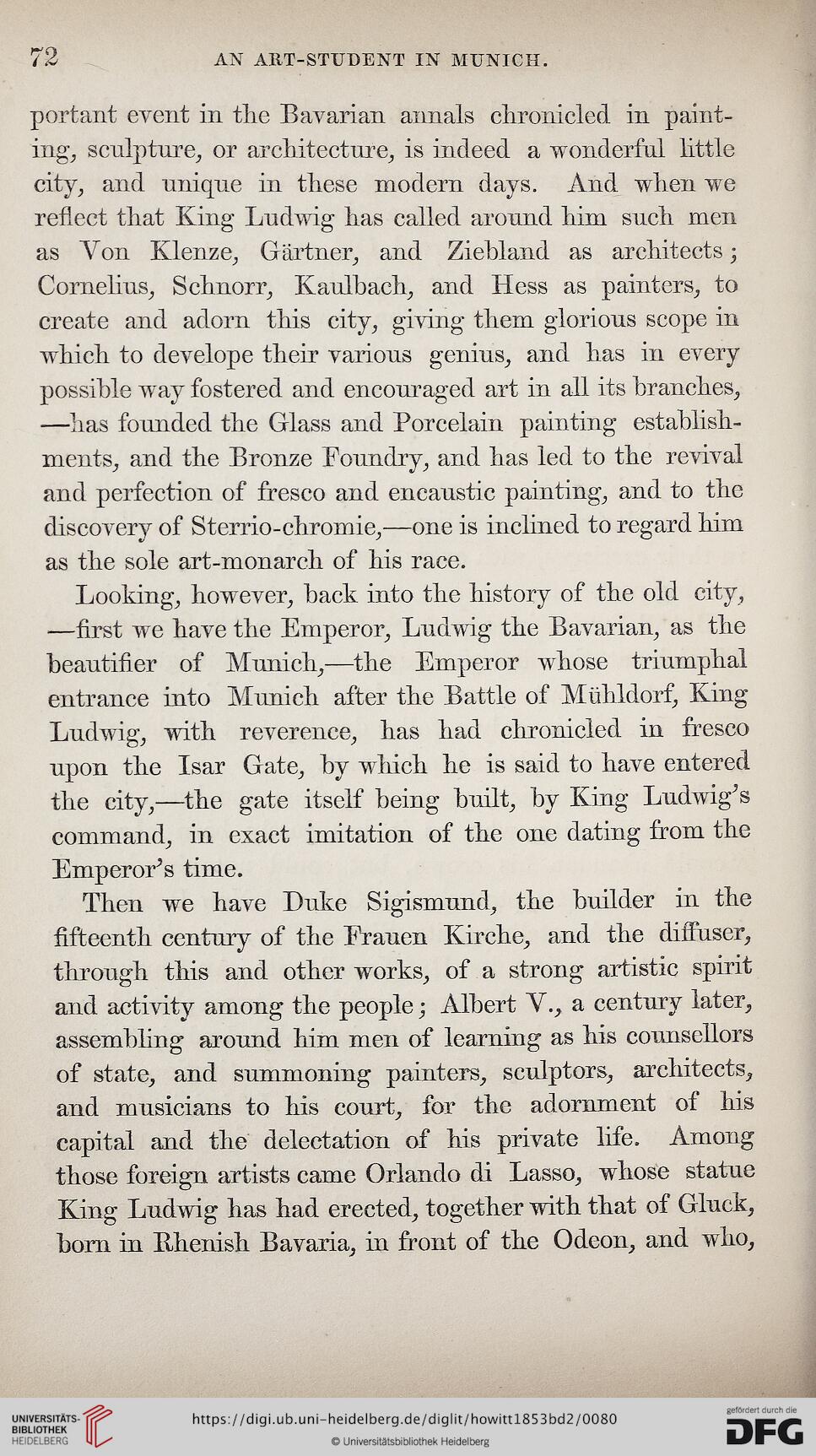72 AN ART-STUDENT IN MUNICH.
port ant event in the Bavarian annals chronicled in paint-
ing, sculpture, or architecture, is indeed a wonderful little
city, and unique in these modern days. And when we
reflect that King Ludwig has called around him such men
as Von Klenze, Gartner, and Ziebland as architects;
Cornelius, Schnorr, Kaulbach, and Hess as painters, to
create and adorn this city, giving them glorious scope in
which to develope their various genius, and has in every
possible way fostered and encouraged art in all its branches,
—has founded the Glass and Porcelain painting establish-
ments, and the Bronze Foundry, and has led to the revival
and perfection of fresco and encaustic painting, and to the
discovery of Sterrio-chromie,—one is inclined to regard him
as the sole art-monarch of his race.
Looking, however, back into the history of the old city,
—first we have the Emperor, Ludwig the Bavarian, as the
beautifier of Munich,—the Emperor whose triumphal
entrance into Munich after the Battle of Miihldorf, King
Ludwig, with reverence, has had chronicled in fresco
upon the Isar Gate, by which he is said to have entered
the city,—the gate itself being built, by King Ludwig’s
command, in exact imitation of the one dating from the
Emperor’s time.
Then we have Duke Sigismund, the builder in the
fifteenth century of the Frauen Kirche, and the diffuser,
through this and other works, of a strong artistic spirit
and activity among the people; Albert V., a century later,
assembling around him men of learning as his counsellors
of state, and summoning painters, sculptors, architects,
and musicians to his court, for the adornment of his
capital and the delectation of his private life. Among
those foreign artists came Orlando di Lasso, whose statue
King Ludwig has had erected, together with that of Gluck,
bom in Rhenish Bavaria, in front of the Odeon, and who,
port ant event in the Bavarian annals chronicled in paint-
ing, sculpture, or architecture, is indeed a wonderful little
city, and unique in these modern days. And when we
reflect that King Ludwig has called around him such men
as Von Klenze, Gartner, and Ziebland as architects;
Cornelius, Schnorr, Kaulbach, and Hess as painters, to
create and adorn this city, giving them glorious scope in
which to develope their various genius, and has in every
possible way fostered and encouraged art in all its branches,
—has founded the Glass and Porcelain painting establish-
ments, and the Bronze Foundry, and has led to the revival
and perfection of fresco and encaustic painting, and to the
discovery of Sterrio-chromie,—one is inclined to regard him
as the sole art-monarch of his race.
Looking, however, back into the history of the old city,
—first we have the Emperor, Ludwig the Bavarian, as the
beautifier of Munich,—the Emperor whose triumphal
entrance into Munich after the Battle of Miihldorf, King
Ludwig, with reverence, has had chronicled in fresco
upon the Isar Gate, by which he is said to have entered
the city,—the gate itself being built, by King Ludwig’s
command, in exact imitation of the one dating from the
Emperor’s time.
Then we have Duke Sigismund, the builder in the
fifteenth century of the Frauen Kirche, and the diffuser,
through this and other works, of a strong artistic spirit
and activity among the people; Albert V., a century later,
assembling around him men of learning as his counsellors
of state, and summoning painters, sculptors, architects,
and musicians to his court, for the adornment of his
capital and the delectation of his private life. Among
those foreign artists came Orlando di Lasso, whose statue
King Ludwig has had erected, together with that of Gluck,
bom in Rhenish Bavaria, in front of the Odeon, and who,




